Sweet Home Chicago: The History of America’s Candy Capital. Exhibit at the National Hellenic Museum. Chicago. 2016.
by David Sutton
In an article titled “The Pioneers of Confection in America,” Steve Frangos notes the “commanding presence [of Greek Americans] in the confectionary industry, dishing up tons of sinfully sweet treats from behind the counters of their candy stores and ice cream parlors” (Frangos 2004, 1). More recently, Frangos has lamented the lack of scholarly interest in the question of why Greek Americans were so central to the confectionary life of the United States. He suggests, speculatively, that something about Greek American taste may have led them into not just the sweet business, but into restaurants, coffee shops, and blended tobacco production in the U.S. (Frangos 2016). He is suggesting here, I believe, that the culture of Greek foodways—or what I refer to in my own work as the “robust food culture” of Greece, in which taste matters on a day-to-day level, may have contributed to this central occupation for Greek Americans. This may have developed, Frangos notes elsewhere, out of the felt need of early Greek male migrants to develop cooking skills, which some later turned to business ends: “A point brought up in every family story is that each man learned to cook Greek food and bake bread” (Frangos 2003).
How does this apply to the confectionary business? Consider the centrality of sweet shops (zacharoplasteia) in Greek communities as both places to purchase a tray of galakotoboureko, or other gifts to bring to celebrate a name day, and social spaces themselves, which, until recently, were explicitly marked as family and mixed-gender spaces in opposition to the all-male coffee shops. Then there are the spoon sweets, made from anything from quince to carrots, which many women offer as part of home hospitality (See Cowan 1991), and which has become an attractive alternative to buying sweets during the current economic crisis for some women on Kalymnos (where I conduct my ethnographic research). Others recall a pre–World War II Kalymnos, when itinerant candy makers would pass through neighborhoods selling all sorts of sweet treats from their carts.
It is this terrain of Greek American confectionary that is the focus of a recent (autumn 2016) exhibit presented at the National Hellenic Museum in Chicago entitled “Sweet Home Chicago: The History of America’s Candy Capital.” This was part of a larger exhibit developed by the Elmhurst History Museum on the culture of candy in Chicago, with no particular attention to Greek Americans. The National Hellenic Museum has adapted the exhibit by adding an additional eight panel displays focusing on the role of Greek Americans in sweet shops and the candy business in the United States.
The tone of the overall Chicago exhibit is, not surprisingly, nostalgic, meant, no doubt, to capture the way that childhood memories can be encapsulated in candy; the stress is on telling the history of candy making in Chicago while presenting photographs and objects that will, perhaps for many, act as a Proustian madeleine in unlocking “the vast structure of recollection” (cited in Sutton 2001, 84). Thus one panel on “Serving Unique Audiences” presents a section including images of Willy Wonka products marketed to children, licorice as a medicinal “adult” candy, and the popularity of chocolate bars for school band fundraisers. The same panel also includes information about vitamin-infused candy as evidence of Americans’ enthusiasm for vitamin supplements earlier in the twentieth century, as well an image of Charlie Chaplin, from the film The Gold Rush eating his boot, which was made of licorice and provided by the American Licorice Company. Another panel highlights the role of immigrants in Chicago candy making with several pictures and objects from candy makers such as Bunte Bros. and Bowes-Allegreti, and accompanying text noting that “Gustav A. Bunte, born in Germany, was one of dozens of immigrants who opened confectionary businesses in Chicago. By 1890, 79 percent of Chicagoans were born abroad or were children of immigrants.”
The eight panels appended to the exhibit by the Hellenic National Museum focus on Greek American immigrant confectioners, though with a geographical scope broader than Chicago, extending to the wider Midwest region. These panels tend to touch on themes of family connections and family histories, occasionally broadening into larger community issues. I will discuss the panels individually.
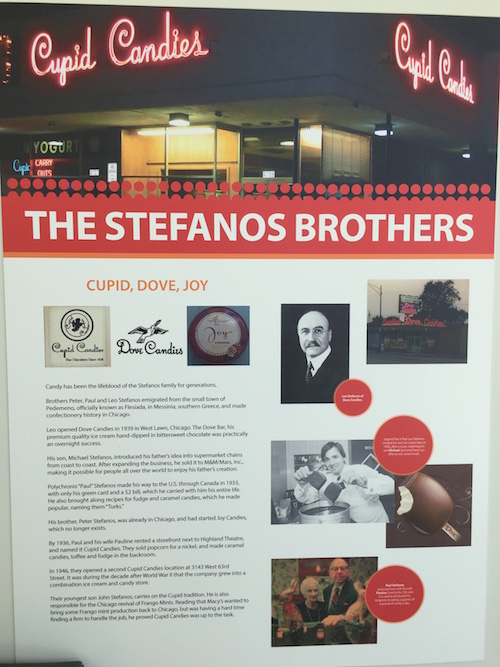
A panel entitled “The Stefanos Brothers” describes the three brothers who came to the United States from Messinia in the 1930s and who went on to “ma[k]e confectionary history in Chicago.” The panel briefly tells the story of Dove Candies, Joy Candies, and Cupid Candies (a few objects including candy molds are included in a nearby display case). Leo Stefanos opened Dove Candies. He was the inventor of the ubiquitous Dove Bar of ice cream covered with bittersweet chocolate, was “practically an overnight success.” The eventual sale of Dove by the inventor’s son to M&M/Mars Inc. is presented as a further success, “making it possible for people all over the world to enjoy his father’s creation.” Another Stefanos brother, Polychronos, or “Paul,” brought with him, presumably from his home village, recipes for fudge and caramel and naming them “Turks,” (one of the few references to intercommunal relations, even, in this case, based on the stereotype of Turkish dark skin). He opened Cupid candies, which flourished in different Chicago neighborhoods before becoming newly relevant in later decades as they contracted to produce Marshall Field’s famous “Frango Mints” line.

The theme of entrepreneurial business success repeats through a number of panels.1 For example, the panel entitled “Gayety’s Candies” highlights the fact that United Airlines chose it from among 45 international competitors to produce chocolate truffles for their premium service flights. This frames the humble beginnings of Gayety’s (named after a local movie theater), once again a story of early twentieth century migration (from Alepohori in Tripoli) and family continuity, as Gayety’s built its business around proximity to Chicago’s south side steel mills. Even after the steel mills closed, Gayety’s revived its business in suburban Lansing, playing on nostalgia for the old-fashioned ice cream parlor: “with its comfortable booths, traditional ice cream tables and picture gallery, Gayety’s continues to be the place where everyone’s treated like royalty.”
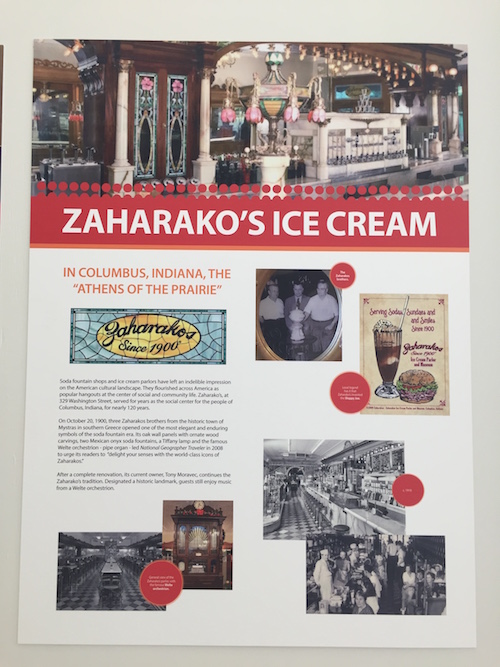
Ice cream parlors as a kind of everyday luxury is the focus of the panel “Zaharako’s Ice Cream,” featuring the soda fountain of the Zaharakos brothers from Mystras, who opened their establishment in 1900 in Columbus, Indiana. Though no longer run by the Zaharakos family, it is still open today, surrounded by oak wall panels with elaborate carvings, Mexican onyx soda fountains, a Tiffany lamp, and a Welte orchestron pipe organ, now a historic landmark. Aside from impressive photos, however, very little other details are provided of this gathering place. We are led to believe that it was part of a thriving Greek American community, as the panel refers to Columbus as “the Athens of the Prairie.” But little else of the social, and class, milieu of Zaharakos is provided, leaving us to question whether we should imagine it as a typical American soda fountain of 1950s “Happy Days” imagery, a family gathering place, or an ethnic enclave (or all of the above at different moments).
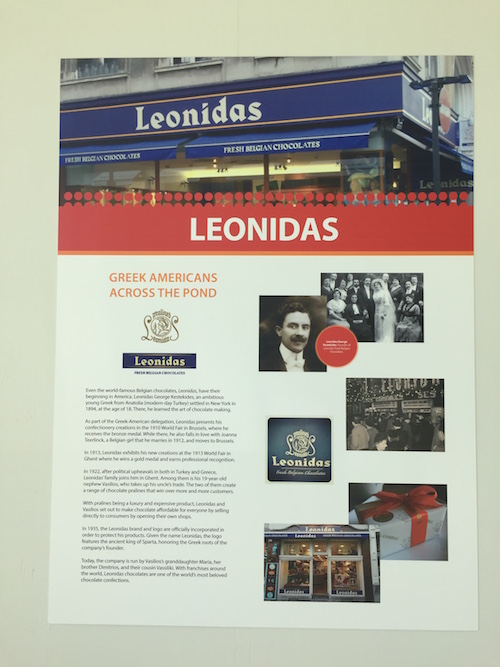
A panel entitled simply “Leonidas” describes the eponymous chocolate company founded by Greek American Leonidas Kestekides, from Anatolia. Interesting here is the suggestion of a transnational community responsive to larger political events: Leonidas left New York to present his chocolates at the 1910 World’s Fair in Brussels. There he met and married a Belgian woman and decided to move his production there. Later, buffeted by the events of 1922 (the Asia Minor catastrophe; not explicitly described in the panel), Kestekides’s family migrated to Belgium, where they join in the family business. Leonidas’s nephew Vasilios in particular helps him to expand the business from luxury products only to different candy lines available to the general public. The company continues in the same family, currently run by the granddaughter of Vasilios and her family members, tying together four generations through space and time. Anthropologically, this recalled for me questions about the tangled relationship of the challenges and tensions of capitalist reproduction and family reproduction, which would no doubt be too much for a small exhibit, but might be worth exploring in some future venue.2
“Crown Candy Kitchen” features another extant soda fountain, this one in St. Louis, founded by two immigrants from “a small village in Macedonia.” Interestingly, the panel notes that Harry Karandzieff and Pete Jugaloff 3 “brought their confectionary skills from Greece where they had grown up with honeyed sweets.” This brief snippet is one of the few references to indigenous Greek sweet-making traditions in the exhibit, and raises questions about the extent that indigenous Greek traditions contributed to the “many other Greek immigrants” who opened confectionary businesses in the United States. This is an old question in migration studies: the extent to which migrant job segmentation is based on cultural differences, available niches in the receiving country, political manipulations, or some combination thereof. However, despite this tantalizing tidbit, it is not clear that Greek sweets had any influence on Crown Candy Kitchen, whose current menu does not include anything recognizably Greek, even though, according to the panel, “it is known for its steadfast dedication to remaining the same.”
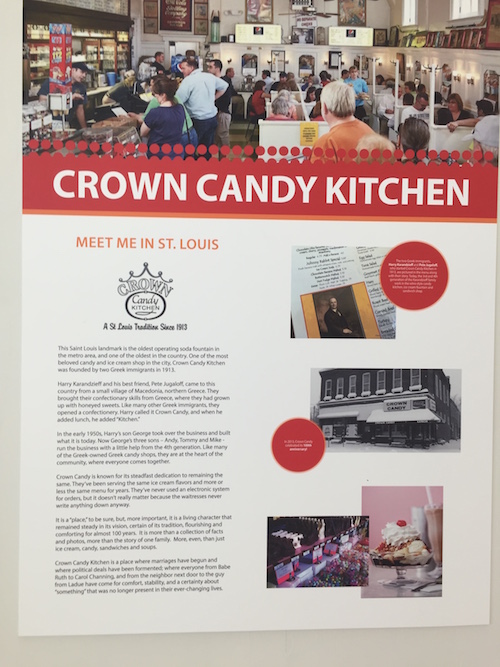
Interestingly, though different from Zaharako’s in its lack of any luxury trappings in its decor, Crown Candy Kitchen is very much described here as a particular kind of place, “a living character that remained steady in its vision, certain of its tradition, flourishing and comforting for almost 100 years.” The panel describes a prototypical “third space,” in Ray Oldenberg’s () terminology: that space that is neither home nor work, but a venue for neighborhood sociality and community building, a function served alternately by restaurants, coffee shops, bars, or bowling alleys in many communities, and played on by the show Cheers as the place “where everybody knows your name.” Thus the panel stresses that it is “where marriages have begun and where political deals have been formented [sic]; where everyone from Babe Ruth to Carol Channing, and from the neighbor next door to the guy from Ladue have come for comfort, stability, and a certainty about ‘something’ that was no longer present in their ever changing lives.” Once again, this is not particularly Greek, despite the fact, as I noted above, that coffee shops and sweet shops are preeminent social spaces in Greece, and seem to have grown in symbolic significance during the economic crisis in which people seek to reaffirm a sense of dignity, continuity, and sociability in the face of the ravages of austerity. The potential for exhibits exploring the similarities and differences in this regard seems once again quite clear.
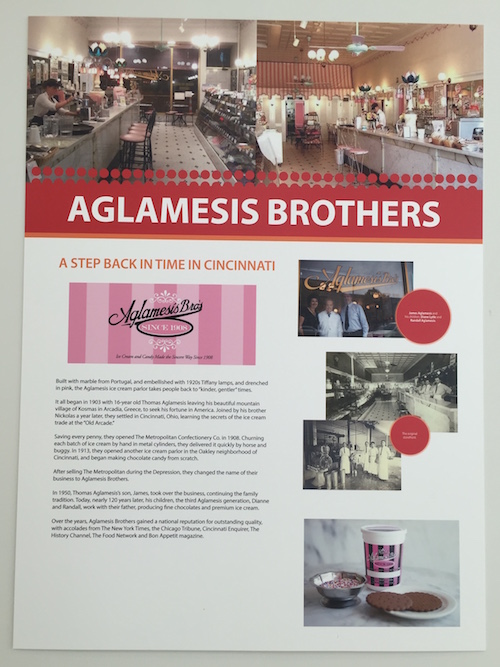
“Aglamesis Brothers” describes the eponymous ice cream parlor in Cincinnati, established by two migrants from the village of Kosmas in Arcadia. While by and large repeating the themes from other panels—another successful family business spread through the Midwest but with a “national reputation for outstanding quality” and passed down across the generations—this panel further stresses the notion that handmade products are key to that success, endurance, and reputation. Indeed, it is in making chocolate “from scratch” and churning each batch of ice cream “by hand” that Aglamesis Brothers provides “a step back in time.” The evocation of craft as key to this kind of success is reflected also in the ways that the brothers established their business. Not, in this case, through prior knowledge, but from acquiring “the secrets of the trade” in Cincinnati. This reference to the kind of transmission that goes on between masters and apprentices, or even in everyday life in Greece, has been much studied by anthropologists such as Herzfeld’s work on artisan potters in Crete (2003) or my own work on the transmission of cooking knowledge on Kalymnos (Sutton 2014). These works stress the complexity of socially situated learning in which teaching is often not explicit but part of becoming a member of a “community of practice” (Lave and Wenger 1991) and learning to “steal the knowledge with your eyes.” This is once again only to suggest that much work needs to be done to understand the kind of processes that allowed the flourishing and transmission of confectionary businesses among Greek Americans.4
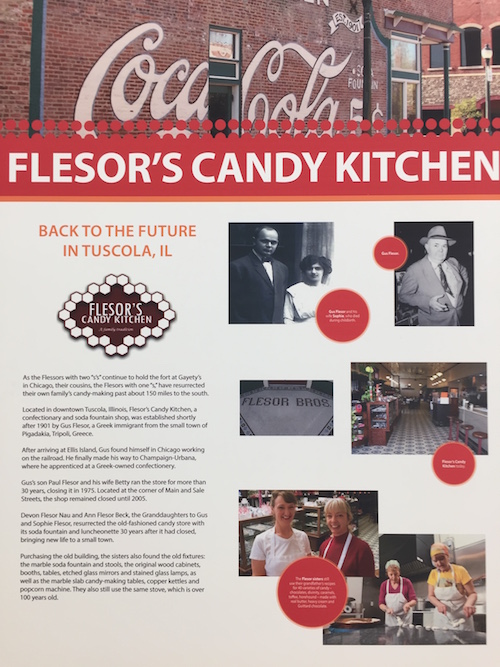
Whereas the first six panels focus more on family tradition, two final panels deal with the theme of reinvention, or reclaiming of tradition. “Flesor’s Candy Kitchen” is subtitled “Back to the Future in Tuscola, Illinois.” Cousins of the Flessors, (double S) of Gayety’s, this confectionary/soda fountain was founded by Gus Flesor and his brothers from Pigadakia, Tripoli. Gus learned his sweet-making skills as an apprentice at a Greek confectionary in Champaign-Urbana, as part of a move of some of the Greek community downstate, before he migrated further south to Tuscola. While Flesor’s closed in 1975, it was resurrected after 2005 by two granddaughters of Gus, “bringing new life to a small town,” suggesting the role of the metaphor of Anastasi in this particular revitalization. When the granddaughters purchased the building where Flesor’s resides, they found all of the old fixtures intact, the exhibit tells us, “as well as the marble slab candy-making tables, copper kettles and popcorn machine. They also still use the same stove, which is over 100 years old.” Here it seems tradition is revalidated through memory as well as through the material remains of the past, even if these remains are strictly of the small-town Americana variety. A perusal of the menu shows typical luncheonette/ice cream parlor fare, with the addition of a gyros and Greek salad serving as a reminder of an ethnic past.
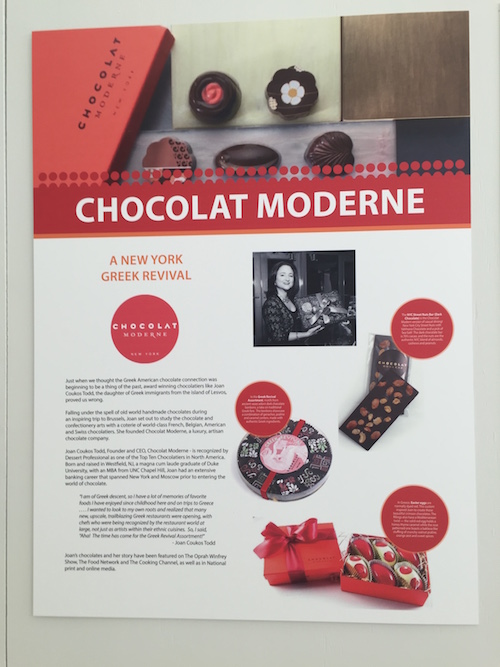
Finally, the last panel departs from the Midwest: “Chocolat Moderne” describes a “New York Greek revival.” Joan Coukos grew up in New York, the daughter of immigrants from Lesvos. She recounts memories of her favorite foods both eaten at home with her family and on trips to Greece. But it was on a trip to Belgium where she began to learn the art of chocolate making. After twenty years in banking, she opened Chocolat Moderne, a high-end, artisanal chocolate shop to much critical acclaim. In Coukos’s case, the connection with tradition is more emblematic than direct, though she does feature a “Greek revival” chocolate line, decorated with Ancient Greek vases and geometrical patterns and made with “authentic Greek ingredients.” Chocolat Moderne seems to represent the ethnicity of choice, described in the following quotation from Coukos herself: “I wanted to look to my own roots and [I] realized that many new, upscale, trailblazing Greek restaurants were opening, with chefs who were being recognized by the restaurant world at large, not just as artists within their ethnic cuisines.’” This is also the one panel that focuses on the role of a female entrepreneur in the confectionary world, which raises questions about the association of sweetness itself with femininity. Not to deny that Greek men may love their sweets! But sweetness, itself, is gender marked in Greece—and elsewhere—as Cowan has persuasively shown in her ethnography set in northern Greece in which she argues that by ingesting sweet substances, “Sohoian girls and women literally produce themselves as properly feminine persons. Consuming sweets, they do what they ‘should’ (observe the etiquette of guest-host relations) as well as what they ‘want’ (since they are thought ‘naturally’ to desire sweets), a conflation of moral propriety and desire that obscures the coercive aspects of such consumption” (184).
Aside from the question of taste, as noted by Steve Frangos as well, it would be interesting in the future to consider the relationship of Greek American confectioners to the tradition of sweet consumption in Greece itself. “Sweet Home Chicago” makes clear that Greek American confectioners have not been working in a so-called ethnic ghetto of food traditions defined by Greekness, but have rather, from the beginning, in one way or another, developed their professions in a recognizably American context of soda fountains, candy, and ice cream. A more complex picture, however, could no doubt be portrayed in more explicitly drawing out some of the Greek ingredients, tastes, and social practices that tie sweets to identity and the reproduction of cultural life.
In viewing this exhibit, I found it hard not to look wistfully across Halstead Avenue to the Pan-Hellenic Pastry Shop, with its offerings of kourabiedes, galaktoboureko and baklava, and to wonder why it was not included in the exhibit. It, too, was founded by immigrant siblings who learned their craft without explicit professional training: “’It’s just something that’s done by tradition. You grow up learning about these things’” notes founder Louis Manolakos (Cantrell 1991). Perhaps it is because this story only stretches back to the 1950s, when Louis first attempted to open a pastry shop in Montreal. He found his Greek customers lacking money to spend to support his business, unfortunately, so, in 1973, he moved it to Chicago’s Halstead Avenue. The Pan-Hellenic Pastry Shop’s menu offers a lovely mix of identifiably Greek sweets alongside other bakery classics such as Black Forest Cake, as well as the owner’s own creations such as Louie’s cookies: a chocolate and walnut meringue combination with fudge in the middle.5 Any consideration of Greek sweets also must include koliva, the Greek funeral food (made from boiled wheatberries, nuts, almonds, pomegranate seeds, and other ingredients covered with a layer of sugar) and served at memorial services for the dead and on All-Souls day. With koliva we see how sweets play a central role in the identity and memory of the community (Sutton 2003), not to mention how they are gender linked: on Kalymnos, for example, they’re invoked by wives as threats to their husbands: “Watch out or I won’t make koliva in your memory after you die!” One wonders whether bakeries such as these, or even more “Americanized” ones portrayed in this exhibit, provide koliva for memorial ceremonies (mnimosina) in the United States. As much as we learn from “Sweet Home Chicago,” it would be interesting to know what impact tastes for koliva, melomakarona, or kadaifi—and their corresponding social spaces and cultural practices (whether in the home or at festivals, and as a part of rituals and celebrations, as well as their presence in various shops and businesses)—might have on the ways in which Greek Americans negotiate their identity in the twenty-first century.
Coda . After finishing this review, I was driving from Southern Illinois to Chicago and decided to stop for lunch in Tuscola, Illinois, at Flesor’s Candy Kitchen. The main room was hopping with customers, so I only got to speak briefly with Devon, one of the two sisters who reopened Flesor’s in the early 2000s, and granddaughter of founder Gus. She told me that they were “half-Greek,” and that there were only tiny Greek communities in places like Tuscola. Her grandmother, Gus’s wife, had died at thirty, after having born eight children. She invited us to roam through the back room, which included old photographs and a wall that displayed old-fashioned ice cream dishes, among other memorabilia. And she told me about her sister, Ann, who was absent that day, but who had recently completed a PhD at the University of Illinois at Champaign-Urbana on Greek migrants in central Illinois, with a focus on the significant number who went into the confectionary business. The dissertation explores how the migrants learned the confectionary business from each other, as well as the various prejudices and Klan activity they faced during the course of the twentieth century. It includes an in-depth chapter providing the oral histories of her grandfather and other migrant confectioners in central Illinois. 6 The menu at Flesor’s included a gyros and Greek salad along with the typical American diner fare. I ordered a Greek salad, which turned out to be very ordinary. But the candy, including such treats as chocolate-covered dried apricots, was indeed delicious!
David Sutton is Professor of Anthropology at Southern Illinois University Carbondale. Since the early 1990s he has been conducting research on the island of Kalymnos and has published three books based on this research: Memories Cast in Stone: The Relevance of the Past in Everyday Life (Berg, 1998), which explores Kalymnian historical consciousness, Remembrance of Repasts: An Anthropology of Food and Memory (Berg, 2001), and Secrets from the Greek Kitchen: Cooking, Skill and Everyday Life on an Aegean Island (California, 2014). He has been currently researching the role of food in understanding the Greek economic crisis, some of which is published in “’Let Them Eat Stuffed Peppers: An Argument of Images on the Role of Food in Understanding Neoliberal Austerity in Greece” ( Gastronomica: The Journal of Critical Food Studies 16(4): 8-17).
Notes
1. For a discussion of the narrative of entrepreneurial success among Greek Americans, see Anagnostou (2003). “Entrepreneurial genius” is the phrase used in a short description of the exhibit which appeared in the Greek American newspaper The Greek Reporter (Kolasa-Siklaridi 2016).
2. The tensions of family capitalism have been explored in many forms in anthropological scholarship. See, for example, Yanagisako (2002); and with a specifically food focus, see (Lem 2007; Mars 2007).
3. No comment is made in the exhibit on the Slavic spelling of these names except to insist that they were “Greek migrants.”
4. See also Frangos (2004a), who suggests that early “pioneers of confection” such as Christos Tsakonas, would train other Greeks from the same family, village or region and then sold supplies so that they could presumably set up their own businesses. He also notes the role of fraternal organizations in setting up self-help buying cooperative to supply store-owners.
5. https://locu.com/places/pan-hellenic-pastry-shop-chicago-us/ . Note that the shop closed in May of 2017, but the owners hope to reopen in a new location and offering an expanded menu in May of 2017. See: https://www.dnainfo.com/chicago/20170531/greektown/pan-hellenic-bakery-closes-greektown-louie-manalakos-helena-james-athena .
6. Flesor-Beck (2014). See also the social-historical work of Steve Frangos on Midwestern confectioners: Frangos (2003; 2004a; 2004b).
References Cited
Anagnostou, Yiorgos. 2003. “Model Americans, Quintessential Greeks: Ethnic Success and Assimilation in Diaspora.” Diaspora: A Journal of Transnational Studies 12: 279–327.
Cantrell, Wanda. 1991. “Greek Town Baker Finds Sweet Success.” Chicago Tribune 11 September. Accessed 16 April 2017. http://articles.chicagotribune.com/1991-09-11/news/9103080869_1_bakery-greek-town-candy
Cowan, Jane. 1991. “Going out for Coffee? Contesting the Grounds of Gendered Pleasures in Everyday Sociability.” In Contested Identities: Gender and Kinship in Modern Greece. Edited by Peter Loizos and Evthimios Papataksiarchis, 180–202. Princeton, NJ: Princeton University Press.
Flesor-Beck, Ann. 2014. Greek Immigration to, and Settlement in, Central Illinois 1880-1930 . PhD diss. The University of Illinois Urbana/Champaign. ProQuest 3673398.
Frangos, Steve. 2003. “Eulogy for the Diana Sweet Shoppe.” The National Herald 1-2 March.
———. 2004a. “The Pioneers of Confection in America.” The National Herald. 21 February.
———. 2004b. “The Sweet Smell of Success.” The National Herald 2–3 January.
———. 2016. “On the Question of Greek-American Taste.” The National Herald 5 December. Accessed 15 April 2017. https://www.thenationalherald.com/143569/question-greek-american-taste/
Herzfeld, Michael. 2003. The Body Impolitic: Artisans and Artifice in the Global Hierarchy of Value . Chicago: University of Chicago Press.
Kolasa-Siklaridi, Kerry. 2016. “My Sweet Home, Chicago: Exhibit Tells History of Greek Immigrants and America’s Candy Capital.” The Greek Reporter 13 June. Accessed 15 April 2017. http://usa.greekreporter.com/2016/06/13/my-sweet-home-chicago-exhibit-tells-history-of-greek-immigrants-and-americas-candy-capital/
Lave, Jean, and Etienne Wenger. 1991. Situated Learning: Legitimate Peripheral Participation. Cambridge: Cambridge University Press.
Lem, Winnie. 2007. “Daughters, Duty and Deference in the Franco-Chinese Restaurant.” In The Restaurants Book: Ethnographies of Where We Eat. Edited by D. Beriss and D. Sutton, 133–150. Oxford: Berg.
Mars, Gerald. 2007. “Food, Family and Tradition in Northern Italy: The Rise and Fall of a Michelin-Starred Family Restaurant.” In The Restaurants Book: Ethnographies of Where We Eat. Edited by D. Beriss and D. Sutton, 167–187. Oxford: Berg.
Oldenberg, Ray. 1999 [1989]. The Great Good Place. Boston: De Capo Press.
Sutton, David. 2001. Remembrance of Repasts: An Anthropology of Food and Memory. Oxford: Berg.
______. 2003. “Kollivo.” Slow: The Magazine of the Slow Food Movement. 7: 104-107.
———. 2014. Secrets from the Greek Kitchen: Cooking, Skill and Everyday Life on an Aegean Island. Berkeley: University of California Press.
Yanagisako, Sylvia. 2002. Producing Culture and Capital: Family Firms in Italy. Princeton: Princeton University Press.
